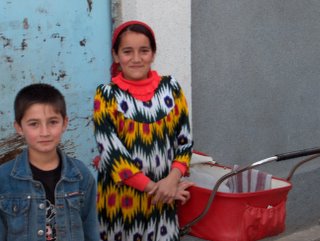Out of Dushanbe

Yesterday we got up early to make the two hour drive to the southern region of Tajikistan. This was my first real venture out of Dushanbe and I was anxious to see what the differences were. Somewhere around 70% of Tajikistan is mountains so to go from one area to another you have to pass through them on winding narrow roads. Our driver takes a certain amount of sick pleasure in seeing how fast he can go in order to freak out the Americans. As I may have mentioned before, there are no real rules regulating driving here. Although some streets have lanes painted on them I think this is purely decorative as they are routinely ignored. People simply drive where they want and then use their horns to alert the other drivers, or pedestrians, or livestock of their presence. The drive to the south is fascinating, despite the rain, there were people herding livestock and girls with sacks of cotton riding donkeys along the side of the road.
When we were preparing to come to Tajikistan we were warned that the electricity is scarce and often goes off for hours at a time. (The official reason for this is that the demand for electricity had exceeded the supply ever since the Tajiks were cut off from the Soviet grid and so now they buy from Uzbekistan and the power gets shut off when the bill gets too high. The unofficial reason is that the Tajik government is apparently selling its power to Afghanistan where they are willing to pay much more for it) We brought head lamps with us but so far have had little use for them. The power is pretty consistent in the capital. In the south, most of the places we went had no power though so we worked in coats and wraps and for our last interviews by candle light.
Because of the mountains, and poverty, and probably many other reasons the different regions seem isolated from both the larger world and from one another. Levels of education are drastically lower in "the regions" and many/most of the women are illiterate. In Dushanbe most people speak Russian, and then maybe Tajik, and there is a pretty even mix of people who dress in "Russian style clothing" which is basically western dress and people who dress in traditional tajik clothing. Traditional clothing for women is a long dress shaped like a nightgown of either velvet with embroidered or sequin flowers, or a cotton with geometric patterns in primary colors over ezors, which are like leggings or fitted pants usually of the same cotton material, and a head scarf. For men it is trousers and a sports coat or a robe and a squared black cap with white embroidery. In the south almost everyone we met was dressed traditionally and very few spoke Russian at all.
We are headed back there on Monday and will be going to several villages of differing sizes - it will be interesting to see the variations between the areas. I am definitely going to bring my headlamp and warmer clothing though.
Post a Comment